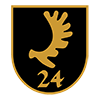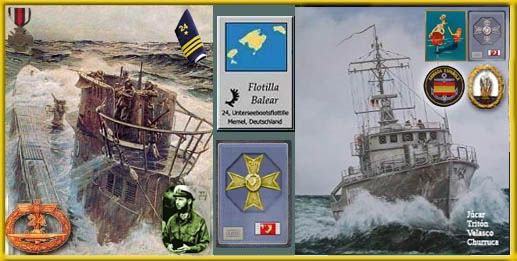captured enemy merchants and took it back to Germany as prize. Also,
during the early part of the war, merchants were stopped and then
sunk, not by torpedoes or gunfire, but by sending a boarding party
on board to scuttle it.
The following describes the operational procedure from the U-Boat
Commander's Handbook, which was an official publication by the
Kriegsmarine during the war.
When dealing with steamers, commanders should observe the Prize
Regulations at all times. Sinking a steamer without warning is
prohibited, unless it is a warship or escorted by a warship or
aircraft.
When stopping steamers, proceed cautiously as the enemy is known to
employ decoys (armed ships but disguised as merchants - Q ships).
For this, at least two torpedoes are placed on standby and ready to
fire. While remaining submerged, inspect the steamer at close range
for any suspicious characteristics. Nationality markings and ship
designations should be observed whether they are permanent or have
been tampered with. Be on the lookout for makeshift superstructures
and suspicious cabin windows, as these are signs of concealed guns.
If the ship bears no suspicious characteristics, then surface at a
minimum safe distance of 4000 meters astern of the steamer. Act
resolutely to stop the steamer and order the crew to board their
life rafts and abandon ship. If any resistance is encountered, then
it is treated as hostile and may be sunk immediately. Acts of
resistance includes not stopping immediately, failure to obey
instructions, sending radio messages of any kind, or not evacuating
the ship promptly.
Should the need arise to conduct further inquiries, never send a
boarding party to board the steamer. Instead, ask for the ship's
papers to be sent over. A close watch should be kept on the boarding
crew coming alongside. The boat's crew must be armed with submachine
guns and automatic pistols on the conning tower, so as to prevent any
hostile actions such as the lobbing of hand grenades.
During the entire time of operation, the U-boat should keep a minimum
distance of 4000 meters behind the steamer. Point the boat at the
steamer and keep directly behind the stern to prevent any surprise
artillery fire - in the event, only the stern gun of the steamer can
be used. Ships have a natural tendency to broach to one side, and any
broaching should be countered with counter maneuvering. If such
movements are repeated suspiciously, then open fire at once with live
ammunition. The danger zone is in the immediate vicinity of the
steamer, on which submarine traps (if any) pin their greatest hopes
on.
As per standard procedure, four lookouts must be posted to scan their
respective horizons for ships, the sky for aircraft and the surface
for periscopes. Lookouts are to strictly carry out their duties and
are forbidden from observing the happenings with the steamer, or lest
the boat be surprised by a lurking enemy. It should be noted that
gunnery fire may be heard by ships in the neighborhood, although they
may not be in sight. If this is the case, ships may suddenly arrive
at top speed. As a counter measure, the crew must be ready for a
crash dive. The diesels are always kept running to conserve precious
time during a crash dive.
To sink the steamer with torpedoes, maneuver underwater and fire at
point blank range. If it becomes necessary to use explosives to
scuttle the boat, securely fasten bundles of explosives to the hull
below the waterline. The best places are the hold and the engine
room. Placing explosives above the water line or in cabins or cargo
rooms is virtually useless. In the event of insufficient explosives,
the sea-plugs may be opened although this is somewhat time consuming.
In large ships, smash the windows to prevent the forming of air
pockets.
El relato es en inglés.Una buena oportunidad para practicarlo un poco y al mismo tiempo conocer como comportarse ante uno de estos "buques trampas" que costaron la vida a más de un comandante y toda su tripulación, tanto en la 1ª como en la 2ªGM.
Cortesía de la casa,
Kummetz







